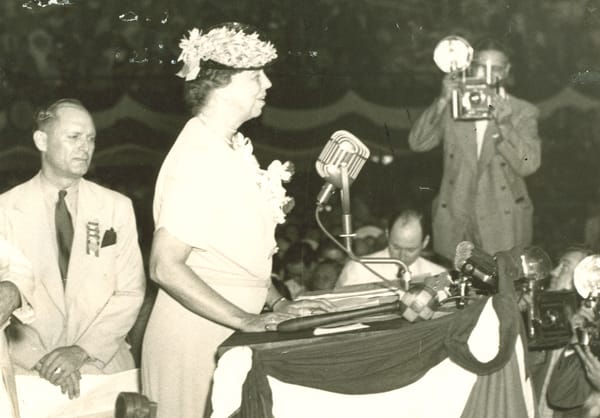The Bastards of Mont Pèlerin
Hayek's Bastards should serve as a reminder to the defenders of Hayek and neoliberalism generally to be vigilant in differentiating themselves from the far right figures and groups that have attempted to graft onto what they defend.

Quinn Slobodian’s Hayek’s Bastards: Race, Gold, IQ, and the Capitalism of the Far Right (2025) is an exploration of the ideological intersections between neoliberalism, far-right politics, and pseudoscientific racism. Slobodian argues that a distorted offshoot of Friedrich Hayek’s economic philosophy has been hijacked by far-right thinkers to create an ideological matrix that fuses free-market absolutism with ethnonationalism and racial hierarchies based upon IQ. He then attempts to connect these to the politics of figures like Donald Trump today. I aim to evaluate Slobodian’s arguments, focusing on the major figures and institutions he identifies as central to this ideological synthesis.
Slobodian’s central thesis is that Hayek’s intellectual edifice, rooted in his arguments for spontaneous order and market mechanisms, has been warped by a group of unwanted “bastards” into a justification for a racially hierarchical social order. A “new fusionism” as he calls it—a play on the “old fusionism” associated with Bill Buckley Jr. Slobodian contends that while Hayek’s ideas weren’t inherently racist, they've been co-opted by figures who have twisted his emphasis on competition and its alleged advantages to legitimize ethnonationalism, restrictive immigration policies, and pseudoscientific claims about racial superiority. The three thematic pillars of the book are race, IQ, and gold. All three are used as defenses against any sort of ameliorative politics. And they form the basis for what he calls the “three hards” meant to keep progressive politics at bay: hardwired human nature, hard borders, and hard money.
Behind the scenes of much of Slobodian’s analysis is Hayek’s so-called “savanna story” (a phrase which Hayek admittedly never used), a just-so story about our species’ ancestors that attempts to use culture in a Lamarckian sense to explain modern human differences. To Hayek certain cultures were simply better at overcoming our small band communitarianism as our species formed larger polities. For Hayek this explains the modern differences between cultures and states. This story, Slobodian argues, is used to naturalize modern inequalities in ways that we can do little about as a matter of policy. In turn certain far-right thinkers invoked the savanna story to argue that humans are biologically predisposed towards inequality, thereby justifying policies like closed borders or racially homogeneous communities as natural extensions of market-driven choices.
The book’s cast of characters and institutions forms the backbone of Slobodian’s case. Murray Rothbard, a pioneer of anarcho-capitalism, and someone who aligned with Hayek’s concept of spontaneous order, is a primary example. In particular Slobodian focuses on Rothbard’s “paleolibertarian” turn in the 1990s, when he forged alliances with various cultural conservatives and ethno-nationalists. Through writings in the Rothbard-Rockwell Report Rothbard defended cultural homogeneity, a shift that Slobodian argues helped lay the groundwork for a synthesis of free-market absolutism and ethnonationalism. Hans-Hermann Hoppe, a disciple of Rothbard, is a similar figure. Hoppe’s concept of private, contract-based societies that could exclude individuals based on cultural or racial criteria (“covenant communities”) is of particular importance to Slobodian’s analysis. It’s a sort of Hayekian spontaneous order towards xenophobic ends that justifies exclusionary communities that prioritizes homogeneity over more universal values.
The Ludwig von Mises Institute, founded by Lew Rockwell (a paleoconservative with a long history of using racial resentment as a political strategy) and closely associated with Rothbard, is a key institution that also disseminated these ideas. Slobodian points to the institute’s conferences and publications, such as The Mises Review, as having provided a platform for thinkers like Hoppe and Rockwell to advance their ideas. It’s also not the only hub for libertarian thought that has overlapped into far-right discourse. Similar critiques are made of the Mont Pèlerin Society (a highly influential invitation-only free market organization that has shaped much of global economic policy since its inception by Hayek and likeminded classical liberals in 1947 through its network of Nobel prize winning economists, government advisors, and scholars) and the Institute for Humane Studies, both of which have hosted or flirted with a number of ethno-nationalists, “race realists,” and the like. As an ex-libertarian I was a bit shocked by the number of hard-right figures the Mont Pèlerin Society in particular found comfortable inviting to its meetings, especially given its outsized role in legitimizing neoliberal thought and the prominent positions of its members.
This gets to one of the book's greatest strengths: Slobodian's careful mapping of the intellectual networks that form far right politics of the Cold War and post-Cold War eras. For example, Slobodian shows how figures like Charles Murray (a Mont Pèlerin Society member) and Peter Brimelow became central nodes in a broader ecosystem of societies and think tanks that fused market fundamentalism with biological determinism. Murray, whose work The Bell Curve provided pseudoscientific justification for racial hierarchies through IQ testing, proved particularly attractive to neoliberals seeking to counter civil rights advances because it offered a seemingly objective, data-driven rationale for opposing state efforts to promote equality in an almost Malthusian sense. Murray and his allies could advocate for pure market solutions while claiming to be above racial politics, envisaging a sort of meritocratic “neurocaste,” (Slobodian's word) based upon IQ. Peter Brimelow, a founder of the white nationalist website VDare and author of Alien Nation, explicitly connected immigration restriction to preserving American economic and cultural superiority and free market economics. Slobodian demonstrates that both had significant influence on the formation of the alt-right.
What all of this suggests is that Hayek's "savanna story" provided an intellectual framework (a “blank check” as Slobodian calls it) that far-right thinkers subsequently appropriated and distorted for their exclusionary agendas, despite Hayek's own intentions. Hayek’s philosophy, whatever else one might think of it, was explicitly universalist and cosmopolitan in its defense of individual liberty and open markets. The far-right thinkers that Slobodian examines, by contrast, prioritized group identity and exclusion from the start. In this sense their engagement with Hayek’s work appears as much opportunistic as foundational. They were seizing upon elements of Hayek’s work that they could twist towards their own ends as much as they were deriving their worldview from Hayek’s principles. This doesn’t mean that Slobodian didn’t find some cringe-inducing racist-adjacent comments by Hayek over the years. Hayek’s remarks about “un-domesticated barbarians” and their unwillingness to accept the “discipline” required of a free market society at a 1976 lecture is highly reminiscent of nineteenth century attitudes towards colonized or enslaved people that merely reinforced unequal social relationships rooted in nothing more than coercion.
Slobodian adeptly shows how the far right, much like previous generations of pseudoscientific racists, misused evolutionary biology to lend scientific legitimacy to their ideologies. Indeed, when figures within the Mises Institute or Mont Pèlerin Society circles draw on discredited race science to justify social inequalities that surely has something to say about the nature of what neoliberalism will tolerate in its defense of free market economics. This broader historical outlook underscores the dangers of pseudoscience in legitimizing discriminatory and bigoted ideologies. Still, this approach has its limitations. While it effectively captures the far right’s tendency to invoke evolutionary metaphors, it, as Slobodian admits at the start, is only one part of the story of how we got here.
Slobodian’s effort to squeeze gold in the narrative is to this reviewer a bit clunky. But it does serve the purpose of demonstrating just how committed far right thinkers were to a certain set of ideas about the state (especially a democratic one) and its role in society. The advocacy for "hard money" became a vehicle for opposing democratic governance and social programs (that were pointless because of natural hierarchies in the first place) that required the flexibility of a fiat currency. That goldbugs and other hard money advocates became part of an alt-right coalition is understandable from this perspective. Hard money meant a so-called natural economic restraint on the government in its efforts to pursue redistributive policies.
What can be said of all of this? First, Slobodian focuses a great deal on a number of minor figures. Individuals like Hoppe (and there are quite a few of them in the book) are frankly marginal compared to more mainstream libertarian or conservative thinkers. This risks giving readers an incomplete understanding of how libertarian and neoliberal thought actually developed and gained prominence over time. As a reader I want to understand just how close a connection existed between these minor figures and some of the larger personalities in the movement. That connection could have been drawn a bit more tightly. Still, given the frequent involvement of these minor characters in the cornerstone institutions of the movement, there is merit to Slobodian’s approach.
Not that all were minor characters. Slobodian doesn't ignore individuals like Milton Friedman, whom he quotes as viewing the Americans with Disabilities Act as a sort of coercive “paternalism” that merely expanded statism at the expense of a laissez-faire social order. This frankly callous and tone-deaf dismissal of disability rights surprised me and it makes me wonder what other views by Friedman I may have missed.
Also, notwithstanding the excellent research that is the heart of the book, Slobodian’s portrayal of Hayek as an accidental progenitor of far-right ideologies is difficult to prove. There is something of a speculative bridge one has to make to go from Hayek’s abstract principles about spontaneous order to the concrete policies of ethno-nationalists. A deeper set of connections needs to be made in order to make this bridge more concrete. That Slobodian focuses so much on intellectual history comes at a cost. Surely there is more going on here in the formation of the alt-right than this. If we think of the alt-right in its broadest scope as a largely online phenomenon based upon white identity politics, and as a loose connection of groups and people opposed to concepts like multiculturalism and feminism, then a larger discussion of how forerunners of the alt-right that Slobodian identifies (like the paleoconservatives or the European New Right) meshed with this new movement seems in order. Slobodian does make a nod to this from time to time, but he could have been more explicit.
Hayek’s Bastards resonates with historical examples of pseudoscience-supported racism, such as the American eugenics movement’s advocacy for forced sterilizations. Slobodian thus underscores the enduring danger of pseudoscience in legitimizing racism and inequality. Of course Slobodian’s work has faced significant criticism from a number of libertarian and neoliberal reviewers of the book (I won't wade into these here), however, I would argue that these largely miss the point. The book should serve as a reminder to Hayek's defenders—and libertarians and neoliberals more generally—to be vigilant in differentiating themselves from the far right figures and groups that have attempted to graft onto what they defend. That a lot of the mainstream organizations in the neoliberal movement chose to invite racist crackpots to their conferences and soirées is exactly the opposite of that, and is merely summoning the sort of confluences that Slobodian discusses in his book. Libertarians could use this opportunity to more forcefully articulate how genuine free market principles are incompatible with racial determinism.
In conclusion, Slobodian effectively highlights the far right’s misuse of evolutionary theory (and IQ), and his analysis of figures like Rothbard, Hoppe, Murray, and Brimelow, as well as institutions like the Mises Institute and the Mont Pèlerin Society, provides a compelling portrait of an ideological undercurrent that has gained visibility in recent years. But his attempt to tie these figures directly to Hayek’s legacy is less convincing, as it relies on a set of speculative connections that need more heft. This isn't to suggest that Slobodian is wrong, just that he needs to demonstrate his claims more concretely. Ultimately, I believe that Slobodian is attempting to provide us with a cautionary tale about how theories of human development, when stripped of ethical moorings, can support exclusionary and oppressive ends.
Featured image is Mont Pèlerin, by Tschubby




